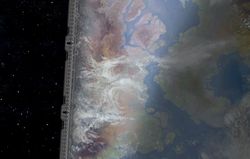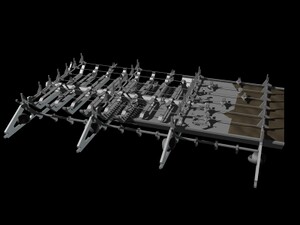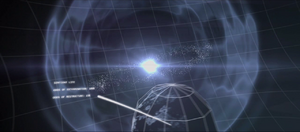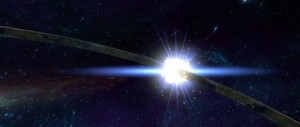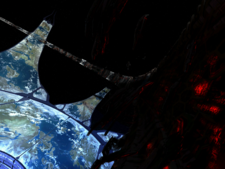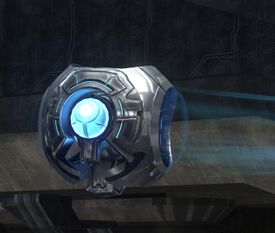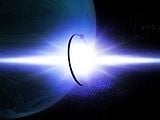Halo Array: Difference between revisions
From Halopedia, the Halo wiki
Sith Venator (talk | contribs) |
No edit summary |
||
| Line 10: | Line 10: | ||
==Background== | ==Background== | ||
[[File:SevenHalos.jpg|thumb|right| | [[File:SevenHalos.jpg|thumb|right|250px|Readout of the seven Halos.]] | ||
[[File:H2_halo_surfaceland.jpg|thumb|right|250px|A section of a Halo's surface.]] | |||
[[File:H2_halo_surfaceland.jpg|thumb|right| | |||
As it is known in modern times, the Halo Array is a network of seven ring-shaped megastructures created by the Forerunners, designed to exterminate all sentient life within the Milky Way galaxy.<ref name="great journey">'''[[Halo 2]]''', level ''[[The Great Journey]]'', '''343 Guilty Spark:''' ''"After exhausting every other strategic option, my creators activated the rings. They, and all additional sentient life in three radii of the galactic center, died, as planned."''</ref> Built following the [[Human-Forerunner War]], these ringworlds were used | As it is known in modern times, the Halo Array is a network of seven ring-shaped megastructures created by the Forerunners, designed to exterminate all sentient life within the Milky Way galaxy.<ref name="great journey">'''[[Halo 2]]''', level ''[[The Great Journey]]'', '''343 Guilty Spark:''' ''"After exhausting every other strategic option, my creators activated the rings. They, and all additional sentient life in three radii of the galactic center, died, as planned."''</ref> Built following the [[Human-Forerunner War]], these ringworlds were later used as a last resort against the Flood, a parasitic extra-galactic species that threatened to consume every sentient life-form in the galaxy. By activating the rings, the Forerunners wiped out every sentient being in the galaxy, effectively starving the Flood to virtual extinction, though specimens were kept in a number of Forerunner [[Flood containment facility|containment facilities]], including the Halo installations themselves.<ref name="library">'''[[Halo: Combat Evolved]]''', level ''[[The Library]]''</ref> | ||
A total of eighteen Halo rings existed during the reign of the Forerunners; an older array of twelve 30, | A total of eighteen Halo rings existed during the reign of the Forerunners; an older array of twelve 30,000-kilometer-wide rings produced by the [[greater Ark]] and six 10,000-kilometer rings, constructed at the newer [[Installation 00|lesser Ark]]. Of these, only seven survived to be included in the final Array. Most of the Halos,<ref name="gas giants">'''Halo: Silentium''', ''page 237''</ref> including the two most well-known Halo installations, [[Installation 04]] and [[Installation 05]], are deployed in orbit over large gas giants, though this is not the case with all of the rings; [[Installation 03]] orbits a rocky planet.<ref name="h4composer">'''Halo 4''', campaign level ''[[Composer (level)|Composer]]''</ref> Installation 04 maintained an atmospheric [[Threshold gas mine|mining facility]] in [[Threshold]]'s atmosphere until [[Battle of the Threshold gas mine|it was destroyed]] by the [[Covenant]].<ref>'''[[Halo 2]]''', level ''[[The Oracle]]''</ref> | ||
Though separated by thousands of light-years, the installations are networked together and capable of remote activation at [[Installation 00|the Ark]], | Though separated by thousands of light-years, the installations are networked together and capable of remote activation at [[Installation 00|the Ark]], their [[intergalactic space|extragalactic]] construction foundry. Each Halo installation has a maximum effective range of 25,000 light-years in every direction.<ref>'''Halo: Combat Evolved Anniversary''', ''[[Terminal/Halo: Combat Evolved Anniversary#Terminal 8|Terminal 8]]'' (''"25,000 light years. That is the effective range of this installation."'')</ref><ref name="radius">'''[[Halo: Combat Evolved]]''', level ''[[Two Betrayals]]'', 343 Guilty Spark: ''"Technically, this installation's pulse has a maximum effective radius of twenty-five thousand light years."''</ref> The method utilized by the array to conduct this "mass sterilization protocol"<ref>'''[[Halo: Combat Evolved]]''', level ''[[The Library]]'', 343 Guilty Spark: ''"Why the Flood is, naturally, simply too dangerous to release, and mass sterilization protocols may again need to be enacted."''</ref> involves the superluminal conveyance of a burst of cross-phased super-massive neutrinos, tuned to emit a harmonic frequency that destroys the nervous system of any life form within range. Simpler organisms lacking a neural system are unaffected, along with inanimate structures. [[Precursor]] technology, however, is extremely susceptible to damage from the Halo effect due to its quasi-living [[neural physics]] composition.<ref> '''Halo: Cryptum''', ''page 132''</ref><ref name="c274"/> | ||
The Halo Array in its entirety has been fired only once in known history, approximately 100,000 years ago, by the [[IsoDidact]] in order to stop the Flood from overwhelming the galaxy. All beings in the Array's effective range, including Forerunners themselves, were wiped out by the Array's pulse,<ref name="great journey"/> with the exception of the [[ | The Halo Array in its entirety has been fired only once in known history, approximately 100,000 years ago, by the [[IsoDidact]] in order to stop the Flood from overwhelming the galaxy. All beings in the Array's effective range, including Forerunners themselves, were wiped out by the Array's pulse,<ref name="great journey"/> with the exception of those who took refuge on the [[shield world]]s. A number of Forerunners survived at the lesser Ark but chose to exile themselves from the galaxy.<ref>'''Halo: Rebirth''</ref> The array has come close to activation three times since; Installation 04 was almost activated by the [[John-117|Master Chief]], Installation 05 was activated by Commander [[Miranda Keyes]] at the behest of the [[Brute]] [[Chieftain of the Jiralhanae|Chieftain]] [[Tartarus]], and [[Avery Junior Johnson|Sergeant Johnson]] was forced by the [[Prophet of Truth]] to activate the Array from the Ark. None of these attempts were successful; the first was stopped by Cortana, while the second and third were halted by UNSC and [[Covenant separatists|Covenant separatist]] intervention. A [[Installation 04B|replacement]] Halo for the destroyed Installation 04 was successfully activated outside of the galaxy, eliminating the Flood massed at [[Installation 00]], but it was incomplete and thus not networked to the rest of the Array.<ref name="halo3halo">'''[[Halo 3]]''', campaign level ''[[Halo (Halo 3 level)|Halo]]''</ref> | ||
Each of the Halo installations in the final Array is given a designation number, from 01 to 07, and is overseen by a single [[monitor]]. The monitors are given control of the Installations' [[Sentinel]] automatons, from [[Sentinel Aggressor|Aggressors]] to [[Constructor]]s and [[Enforcer]]s, and are responsible for containing the Flood test subjects in their [[Flood research facility|research facilities]] and protecting the Halo from intruders. | Each of the Halo installations in the final Array is given a designation number, from 01 to 07, and is overseen by a single [[monitor]]. The monitors are given control of the Installations' [[Sentinel]] automatons, from [[Sentinel Aggressor|Aggressors]] to [[Constructor]]s and [[Enforcer]]s, and are responsible for containing the Flood test subjects in their [[Flood research facility|research facilities]] and protecting the Halo from intruders. | ||
The Array also encompasses [[Installation 00]], an extragalactic construction facility that can create replacement | The Array also encompasses [[Installation 00]], an extragalactic construction facility that can create replacement installations in the event that one is destroyed. All Halos can also be remotely activated from the Ark without being subjected to their effects, as the megastructure is out of the Array's range.<ref>'''Halo 3''', level ''[[The Covenant (level)|The Covenant]]'', '''343 Guilty Spark''': ''"The Ark is out of range of all the active installations!"''</ref> The Forerunners also built [[shield world]]s as a means to escape the effect without having to leave the galaxy.<ref>'''Halo: Ghosts of Onyx''', ''page ??''</ref> | ||
{{clear}} | {{clear}} | ||
| Line 30: | Line 29: | ||
===Construction=== | ===Construction=== | ||
[[File:HaloLatticework.jpg|thumb|right|300px|The foundational latticework of a Halo installation.]] | [[File:HaloLatticework.jpg|thumb|right|300px|The foundational latticework of a Halo installation.]] | ||
The Halos were constructed by the [[ | The first Halos were constructed by the [[Master Builder]] [[Faber]] and his [[Builder]]s in the millennia after the [[Flood]] was first encountered in the Milky Way, only to eventually retreat, seemingly due to [[prehistoric human civilization|early humanity]]'s efforts. The most extreme faction of Builders, which at the time controlled the [[Ecumene Council]], claimed that more extreme measures should be used to protect the galaxy against a possible Flood resurgence and proposed building the Array for this purpose. Although they faced strong opposition from the [[Promethean]]s, led by the [[Didact]], for thousands of years, the faction eventually won the approval of the Council and commenced work on the Array.<ref name="c274"/> | ||
However, at this point, the [[Librarian]] went to the Council and invoked the Mantle, stating the the Halos should be used as biological preserves in the [[Conservation Measure]], a plan to repopulate the galaxy should the Array ever be activated. The Council approved her request, and ordered that the Halo installations be constructed to have a range of natural environments for the Lifeworkers to preserve their biological specimens in. However, the Master Builder later altered the initial plan, and his researchers began to use these specimens for a series of brutal experiments involving Flood infection.<ref>'''Halo: Primordium''', ''page 188-190''</ref> | However, at this point, the [[Librarian]] went to the Council and invoked the Mantle, stating the the Halos should be used as biological preserves in the [[Conservation Measure]], a plan to repopulate the galaxy should the Array ever be activated. The Council approved her request, and ordered that the Halo installations be constructed to have a range of natural environments for the Lifeworkers to preserve their biological specimens in. The Builders also agreed, seeing the inclusion of biological preserves as an effective means of competing with the Didact's shield worlds which incorporated similar measures.<ref name="s44">'''Halo: Silentium''', ''page 44''</ref> However, the Master Builder later altered the initial plan, and his researchers began to use these specimens for a series of brutal experiments involving Flood infection.<ref>'''Halo: Primordium''', ''page 188-190''</ref> | ||
Twelve Halos, each 30,000 kilometers in diameter, were originally commissioned by Master Builder Faber and constructed by the [[guild]] of [[Bornstellar's father]] at the [[greater Ark]], the first Ark installation to be constructed. Only one of these original rings ultimately survived to be used in the Forerunners' final plan; this ring was designated [[Installation 07]]. Later on, an improved, separate array of six installations was constructed at the [[Installation 00|lesser Ark]].<ref>'''Halo: Cryptum''', ''page 329'' (''"Slowly it dawned on me that I was looking upon another array of installations: six rings, each rising from one of the petals of an enormous flower."'')</ref> The final array, activated at the conclusion of the Forerunners' conflict with the Flood, was comprised of seven rings, each 10,000 kilometers in diameter. | Twelve Halos, each 30,000 kilometers in diameter, were originally commissioned by Master Builder Faber and constructed by the [[guild]] of [[Bornstellar's father]] at the [[greater Ark]], the first Ark installation to be constructed. Only one of these original rings ultimately survived to be used in the Forerunners' final plan; this ring was designated [[Installation 07]]. Later on, an improved, separate array of six installations was constructed at the [[Installation 00|lesser Ark]].<ref>'''Halo: Cryptum''', ''page 329'' (''"Slowly it dawned on me that I was looking upon another array of installations: six rings, each rising from one of the petals of an enormous flower."'')</ref><ref name="s250">'''Halo: Silentium''', ''pages 250-251''</ref> | ||
In the later stages of the construction of the first Halos, a Builder named [[Maker-of-Moons]] was assigned to improve upon their designs. The first test deployments had proven the original rings to be unstable and too large to be practically deployed, generating enormous [[Slipstream space#Reconciliation|particle reconciliation]] debt when moved. The original Ark also had several flaws, including the inability to construct smaller installations. Although initially reluctant to admit these defects,<ref name="maker">'''Halo: Silentium''', ''page 91''</ref> the Master Builder, informed by Maker's analysis, commissioned a new Ark and a series of new, more efficient rings several millennia after the first Halos were made; the Builders promoted this as a means to save even more species while being able to create more Halos. The new Ark, known as the lesser Ark or [[Installation 00]], and its six new Halos were constructed in secret,<ref name="s44"/> their location known only to the Master Builder.<ref name="s270">'''Halo: Silentium''', ''page 270''</ref> | |||
The final array, activated at the conclusion of the Forerunners' conflict with the Flood, was comprised of seven rings, each 10,000 kilometers in diameter, one of them being the reduced Installation 07.<ref name="s314">'''Halo: Silentium''', ''page 314''</ref> | |||
===Forerunner-Flood war=== | ===Forerunner-Flood war=== | ||
[[File:HaloFiring.png|thumb|right|300px|The Halo Array fires, ending the conflict.]] | [[File:HaloFiring.png|thumb|right|300px|The Halo Array fires, ending the conflict.]] | ||
The first test of a Halo installation was conducted by [[05-032 Mendicant Bias]], who fired [[Installation 07]] in [[Charum Hakkor system|the system]] of [[Charum Hakkor]] and [[Faun Hakkor]] on a low power setting, destroying all of the sentient life on the latter planet and inadvertently releasing [[ | The first test of a Halo installation was conducted by [[05-032 Mendicant Bias]], who fired [[Installation 07]] in [[Charum Hakkor system|the system]] of [[Charum Hakkor]] and [[Faun Hakkor]] on a low power setting, destroying all of the sentient life on the latter planet and inadvertently releasing [[Primordial|a Precursor]] from captivity on the former planet. Mendicant Bias then brought the released Precursor to the Halo for study and began a 43-year-long interrogation of it. | ||
Following the use of Installation 07 by Master Builder Faber to suppress [[Battle of Janjur Qom|a rebellion]] on the [[San 'Shyuum]] homeworld of [[Janjur Qom]], the other eleven Halo installations were taken to the Forerunner [[Capital]] during the tribunal against Faber, where it was to be decided whether to decommission them. However, in the midst of the trial, Mendicant Bias, turned rampant by the Primordial, appeared with Installation 07, which had gone missing since the San 'Shyuum rebellion, and assaulted the Capital. The AI attempted to seize control of the remaining Halos and fire them, but was only able to control five out of the twelve. One of those five was destroyed by the combined tidal forces of the Capital, the firepower of local Forerunner fleets, and the stress of a recent [[slipspace]] transition. The seven Halos that Mendicant Bias was unable to control were recalled to Installation 00 via slipspace jumps, yet only [[Omega Halo|one]] escaped before the portal collapsed, with the other six breaking up in-slipspace. | |||
Installation 07 jumped into a distant system on a pre-designated destructive collision course with [[Unidentified failsafe planet|a planet]] - a security measure put in place in the event that it fell out of Forerunner control. The installation was eventually reclaimed by the IsoDidact's forces, and it survived the passage of the planet despite taking heavy damage. A significant amount of the ring's superstructure was discarded, reducing its size to 10,000 kilometers, in order to allow it to perform a successful slipspace jump to the [[greater Ark]]. The installation's surviving biological specimens were transported on the Ark and the Flood outbreak on the ring was contained. The ring was refitted to enable it to function in concert with the six final Halos and deployed to its final station in the galaxy; the distribution of the final Halo Array would follow several years later.<ref name="s314"/> | |||
Installation 07 | In the final hours of the Forerunner-Flood war, the ecumene's leadership retreated to the greater Ark, also home to Omega Halo, the sole remaining Halo of the twelve original rings, apart from the repurposed Installation 07. When a [[Battle of the greater Ark|Flood attack]] became imminent, it was decided that the IsoDidact go to the lesser Ark where he would deploy and fire the final Halo Array. Before relinquishing the coordinates to his secret Ark,<ref name="s270"/> the Master Builder met the IsoDidact in the control room of Omega Halo and fired the ring, obliterating a small portion of the [[star road]]s laying siege on the Ark and cleansing [[Path Kethona]] (the Large Magellanic Cloud) of life.<ref name="s273">'''Halo: Silentium''', ''page 273''</ref> | ||
The Flood and the star roads destroyed both Omega Halo and the greater Ark, but the IsoDidact managed to escape to Installation 00 to fulfill his mission. Arriving at the lesser Ark, the IsoDidact, with the assistance of [[Offensive Bias]], deployed the remaining six Halos which, together with Installation 07, comprised the final Halo Array of seven rings.<ref name="s314"/> As Mendicant Bias and the Flood prepared their final assault on the lesser Ark in order to stop the firing of the Halos, the IsoDidact activated the Array. [[Installation 04]] was first in the Array to fire, with the others following sequentially as their fields intersected.<ref name="sil326">'''Halo: Silentium''', ''pages 326-327''</ref> The pulse covered the entire galaxy, killing all sentient life within range and destroying the Precursors' [[neural physics]] architecture, including the [[Domain]] the Forerunners used to hold dear.<ref>'''Halo: Silentium''', ''pages 322-323''</ref> | |||
===Post-activation=== | ===Post-activation=== | ||
The seven Halos then remained relatively dormant for approximately one hundred thousand years, though at least [[Installation 05|one]] of them experienced a major Flood outbreak, and at least [[Installation 04|one]] have experienced brief visits by other species, including a [[unidentified alien vessel|major crash-landing]] in [[40,000 BCE]].<ref>'' | The seven Halos then remained relatively dormant for approximately one hundred thousand years, though at least [[Installation 05|one]] of them experienced a major Flood outbreak, and at least [[Installation 04|one]] have experienced brief visits by other species,<ref>''"[[Conversations from the Universe]]"''</ref> including a [[unidentified alien vessel|major crash-landing]] in [[40,000 BCE]].<ref>'''Halo: Combat Evolved Anniversary''', ''[[Terminal/Halo: Combat Evolved Anniversary|Terminals 5-6]]''</ref> | ||
The Array's activation caused catastrophic damage to ecosystems across the galaxy, with innumerable species both sentient and non-sentient rendered extinct. The dissolving of dead bodies thanks to [[solute]] eventually showed up on the fossil record, and was labeled by scientists as the [[Ross-Ziegler Blip]]. This curious gap was dismissed as an anomaly caused by spatial distortion until [[human]]ity discovered the Array in [[2552]]. Several species indexed by the [[Library Project]] did not survive [[reintroduction]] to their homeworlds, and those that did were all reverted to a [[Technological Achievement Tiers#Tier 7: Pre-Industrial|Tier 7]] technological state. The mostly uneventful period starting after the firing of the Halos was known as the [[dark time]]. | The Array's activation caused catastrophic damage to ecosystems across the galaxy, with innumerable species both sentient and non-sentient rendered extinct. The dissolving of dead bodies thanks to [[solute]] eventually showed up on the fossil record, and was labeled by scientists as the [[Ross-Ziegler Blip]]. This curious gap was dismissed as an anomaly caused by spatial distortion until [[human]]ity discovered the Array in [[2552]]. Several species indexed by the [[Library Project]] did not survive [[reintroduction]] to their homeworlds, and those that did were all reverted to a [[Technological Achievement Tiers#Tier 7: Pre-Industrial|Tier 7]] technological state. The mostly uneventful period starting after the firing of the Halos was known as the [[dark time]]. | ||
| Line 58: | Line 63: | ||
Eventually, the stellar coordinates of [[Installation 04]] was discovered through the combination of a [[Sigma Octanus IV Artifact|crystal artifact]] on [[Sigma Octanus IV]] and a [[Babd Catha Forerunner complex|huge Forerunner artifact]] buried under the surface of [[Reach]]. The coordinates were utilized by the {{UNSCShip|Pillar of Autumn}}'s shipboard [[AI]] [[Cortana]] to escape from the [[Fall of Reach]]. The cruiser arrived over the Installation's orbit and was subsequently shot down by Covenant ships. Most of the ship's combat personnel escaped and made landfall on the artificial construct, triggering the [[Battle of Installation 04]]. | Eventually, the stellar coordinates of [[Installation 04]] was discovered through the combination of a [[Sigma Octanus IV Artifact|crystal artifact]] on [[Sigma Octanus IV]] and a [[Babd Catha Forerunner complex|huge Forerunner artifact]] buried under the surface of [[Reach]]. The coordinates were utilized by the {{UNSCShip|Pillar of Autumn}}'s shipboard [[AI]] [[Cortana]] to escape from the [[Fall of Reach]]. The cruiser arrived over the Installation's orbit and was subsequently shot down by Covenant ships. Most of the ship's combat personnel escaped and made landfall on the artificial construct, triggering the [[Battle of Installation 04]]. | ||
During their investigations on Installation 04, the Covenant encountered a [[Flood containment facility]] and unknowingly released the dormant Flood; they quickly, but only partially, reestablished containment. Soon, a squad of [[UNSC Marine Corps|Marines]] led by [[Captain (Navy)|Captain]] [[Jacob Keyes]] accidentally broke quarantine again, expecting to find a large Covenant weapons cache. The human-waged | During their investigations on Installation 04, the Covenant encountered a [[Flood containment facility]] and unknowingly released the dormant Flood; they quickly, but only partially, reestablished containment. Soon, a squad of [[UNSC Marine Corps|Marines]] led by [[Captain (Navy)|Captain]] [[Jacob Keyes]] accidentally broke quarantine again, expecting to find a large Covenant weapons cache. The human-waged guerrilla war quickly turned into a massive four-way battle between [[UNSC]] forces, the Covenant, [[Sentinel]]s led by [[343 Guilty Spark]], and the Flood. | ||
The battle finally culminated when [[SPARTAN-II Program|Spartan]] [[John-117]] detonated the fusion engines of the ''Pillar of Autumn'' on the surface of the Installation, which compromised the structural integrity of the ring. The gravitational momentum and inertia still perpetuating the ring in orbit around [[Threshold]] then tore the ring apart. The remains of Installation 04 were scattered as debris in space. The explosion sent massive chunks of the ring careening into [[Basis]]; the moon suffered a constant bombardment of debris from the ring after its destruction.<ref>'''Halo 2''', multiplayer level ''[[Burial Mounds]]''</ref> | The battle finally culminated when [[SPARTAN-II Program|Spartan]] [[John-117]] detonated the fusion engines of the ''Pillar of Autumn'' on the surface of the Installation, which compromised the structural integrity of the ring. The gravitational momentum and inertia still perpetuating the ring in orbit around [[Threshold]] then tore the ring apart. The remains of Installation 04 were scattered as debris in space. The explosion sent massive chunks of the ring careening into [[Basis]]; the moon suffered a constant bombardment of debris from the ring after its destruction.<ref>'''Halo 2''', multiplayer level ''[[Burial Mounds]]''</ref> | ||
| Line 72: | Line 77: | ||
By [[2553#January|January 2553]], the UNSC had begun an active search for the remaining Halo Installations.<ref>'''Halo: Glasslands''', ''page 50''</ref> By at least [[2557|July 2557]], UNSC scientists were studying the Array for decommissioning, with facilities at Installations 03 and 05. At the asteroid field orbiting Installation 03, the scientists located the [[Composer]] and accidentally activated it, causing them to become digitized. However, the sensor data left over from the incident led to the discovery of the [[shield world]] [[Requiem]]. Later, the [[Ur-Didact|Didact]] traveled to Ivanoff Station near Installation 03 to retrieve the Composer and used the device to kill the entire research staff before heading for Earth.<ref>'''Halo 4'''</ref> | By [[2553#January|January 2553]], the UNSC had begun an active search for the remaining Halo Installations.<ref>'''Halo: Glasslands''', ''page 50''</ref> By at least [[2557|July 2557]], UNSC scientists were studying the Array for decommissioning, with facilities at Installations 03 and 05. At the asteroid field orbiting Installation 03, the scientists located the [[Composer]] and accidentally activated it, causing them to become digitized. However, the sensor data left over from the incident led to the discovery of the [[shield world]] [[Requiem]]. Later, the [[Ur-Didact|Didact]] traveled to Ivanoff Station near Installation 03 to retrieve the Composer and used the device to kill the entire research staff before heading for Earth.<ref>'''Halo 4'''</ref> | ||
{{Clear}} | |||
==Features== | ==Features== | ||
===Custodial=== | ===Custodial=== | ||
| Line 83: | Line 88: | ||
===Environment=== | ===Environment=== | ||
Although first and foremost designed as weapons of mass destruction, the Halos are also designed as habitats for transplanted lifeforms, including but not limited to humans. After [[Master Builder]] [[Faber]]'s plans were co-opted by [[ | Although first and foremost designed as weapons of mass destruction, the Halos are also designed as habitats for transplanted lifeforms, including but not limited to humans. After [[Master Builder]] [[Faber]]'s plans were co-opted by the [[Librarian]], the Halos were given terrestrial surfaces to support catalogued specimens. The Master Builder intended to allow these specimens to be infected by Flood forms contained on the rings, and then subsequently terminated in order to test the Halos' effectiveness.<ref>'''Halo: Cryptum''', ''pages 313, 334''</ref> The Halo installations support a wide range of environments, habitats, ecosystems, and climates. Installation 04 and Installation 05 supported warm, temperate forests<ref>'''Halo 2''', level ''[[Uprising]]''</ref> that were both deciduous and coniferous, swamps, and cold, snow covered tundra environments.<ref>'''Halo: Combat Evolved''', level ''[[Assault on the Control Room]]''</ref><ref>'''Halo 2''', level ''[[Quarantine Zone (level)|Quarantine Zone]]''</ref> Installation 00 had climate ranging all the way from tundra,<ref name="Cov">'''Halo 3''', level ''[[The Covenant (level)|The Covenant]]''</ref> to forest,<ref name="Cov"/> to desert.<ref>'''Halo 3''', level ''[[The Ark (level)|The Ark]]''</ref> It is unknown whether this range is shared by all the Halos, but the similarity of these environments and that of Installation 00 makes it likely. | ||
While the terrain of a Halo ring may appear to be naturally formed at first glance, it is actually artificially constructed. [[Strato-Sentinel]]s extract raw materials from the source, process them in transit, and deposit building materials at the Installation.<ref>'''[[The Art of Halo 3]]''', page 30</ref> Four huge terraforming factories then move across the face of the installation to "skin" it with landmasses and bodies of water. These factories also hold in the ring's nitrogen-oxygen atmosphere, which is then leaked out to the surface, eventually pouring through the super-structure, and tugged in place by centripetal force.<ref>'''The Art of Halo 3''', ''page 116''</ref> The installation's buildings are then built by Constructors and Sentinels. An intricate layer of metallic panels is laid down several meters below the surface of the terrain, upon which rock, soil, and eventually vegetation is added. Slopes, hills and mountains can be created by sculpting these panels.<ref name="halo3halo"/> Some features, such as landslides, are the result of time, and have been formed naturally. Others, such as the myriad network of tunnels and cave systems that riddle the installation's internal structure, are transit conduits used by the ring's Sentinels and Enforcers. There are also numerous indigenous life-forms that live on the Halos; these were brought on the installations as part of the Lifeworkers' conservation project. | While the terrain of a Halo ring may appear to be naturally formed at first glance, it is actually artificially constructed. [[Strato-Sentinel]]s extract raw materials from the source, process them in transit, and deposit building materials at the Installation.<ref>'''[[The Art of Halo 3]]''', page 30</ref> Four huge terraforming factories then move across the face of the installation to "skin" it with landmasses and bodies of water. These factories also hold in the ring's nitrogen-oxygen atmosphere, which is then leaked out to the surface, eventually pouring through the super-structure, and tugged in place by centripetal force.<ref>'''The Art of Halo 3''', ''page 116''</ref> The installation's buildings are then built by Constructors and Sentinels. An intricate layer of metallic panels is laid down several meters below the surface of the terrain, upon which rock, soil, and eventually vegetation is added. Slopes, hills and mountains can be created by sculpting these panels.<ref name="halo3halo"/> Some features, such as landslides, are the result of time, and have been formed naturally. Others, such as the myriad network of tunnels and cave systems that riddle the installation's internal structure, are transit conduits used by the ring's Sentinels and Enforcers. There are also numerous indigenous life-forms that live on the Halos; these were brought on the installations as part of the Lifeworkers' conservation project. | ||
| Line 99: | Line 104: | ||
The Halo installations are also equipped with drive engines spaced along their rim. In the event of an emergency, a Halo can maneuver itself to avoid damage from a collision or weaponry.<ref>'''Halo: Cryptum,''', ''page 314''</ref> In addition, they possess [[hard light]] reinforcement to stabilize and protect them against tidal and gravitational forces from other objects.<ref>'''Halo: Cryptum''', ''page 311''</ref> One of the most extraordinary systems possessed by the Halos is their ability to lock entire sections of the ring, or, if necessary, the entirety of it, into reflective slipspace stasis. This effectively suspends these sections in time and renders them invulnerable to damage from the outside and allows the occupants of the ring to survive the main weapon's firing. However, it also consumes an enormous amount of energy.<ref>'''Halo: Primordium''', ''page 331-332''</ref> | The Halo installations are also equipped with drive engines spaced along their rim. In the event of an emergency, a Halo can maneuver itself to avoid damage from a collision or weaponry.<ref>'''Halo: Cryptum,''', ''page 314''</ref> In addition, they possess [[hard light]] reinforcement to stabilize and protect them against tidal and gravitational forces from other objects.<ref>'''Halo: Cryptum''', ''page 311''</ref> One of the most extraordinary systems possessed by the Halos is their ability to lock entire sections of the ring, or, if necessary, the entirety of it, into reflective slipspace stasis. This effectively suspends these sections in time and renders them invulnerable to damage from the outside and allows the occupants of the ring to survive the main weapon's firing. However, it also consumes an enormous amount of energy.<ref>'''Halo: Primordium''', ''page 331-332''</ref> | ||
The Halos are capable of repairing themselves to some degree, replacing damaged plates of foundation material and restoring biological sections.<ref>'''Halo: Primordium''', ''page 77-78''</ref> | The Halos are capable of repairing themselves to some degree, replacing damaged plates of foundation material and restoring biological sections.<ref>'''Halo: Primordium''', ''page 77-78''</ref> Some of the 30,000 km-diameter Halos could also be reduced to a smaller size by shedding large portions of the foundation.<ref name="maker"/> In order to prevent the ring from falling apart during this process, it can generate a hard light hub with spokes which hold each of the foundation plates in place.<ref>'''Halo: Primordium''', ''pages 345-346''</ref> However, the self-reduction process was far from perfect and made the original Halos prone to instability and collapse.<ref name="maker"/> | ||
The rings of the second Halo Array are 10,000 km in diameter; this size is roughly similar to that of Earth, which is 12,756 km in diameter. The surface of each ring is 318 kilometers wide.<ref>'''Halo: The Essential Visual Guide''', ''page 6''</ref> The original twelve Halo rings were 30,000 km in diameter.<ref>'''Halo: Cryptum''', ''page 310''</ref> Each installation in the final array orbits a large, dense | The rings of the second Halo Array are 10,000 km in diameter; this size is roughly similar to that of Earth, which is 12,756 km in diameter. The surface of each ring is 318 kilometers wide.<ref>'''Halo: The Essential Visual Guide''', ''page 6''</ref> The original twelve Halo rings were 30,000 km in diameter.<ref>'''Halo: Cryptum''', ''page 310''</ref> Each installation in the final array orbits a large, dense planet—most commonly a gas giant—which serves as a gravitational anchor.<ref name="gas giants"/> For example, Installation 04 and Installation 05 orbited [[Threshold]] and [[Substance]], respectively, which are both large gas giants, while Installation 03 is anchored to a large rocky planet.<ref name="h4composer"/> | ||
===Firing method=== | ===Firing method=== | ||
When activated, the Halo rings release a burst of cross-phased supermassive neutrinos.<ref>'''Halo: Cryptum''', ''page 274''</ref> This burst of neutrinos is carefully tuned to possess a harmonic frequency, which destroys the nervous system of any macroscopic organism that possesses one, even one as rudimentary as a notochord, as shown in the aftermath of a low-powered test firing of a Halo performed by [[Mendicant Bias]] in the system of Charum Hakkor.<ref name="c131">'''Halo: Cryptum''', ''pages 131-133''</ref> Like virtually all Forerunner technology, the Halos are powered by [[vacuum energy]]; when the main weapon is fired, vacuum energy is siphoned from local space-time to near-depletion.<ref name="s270"/> | |||
This pulse is propelled at superluminal speeds and will eventually propagate at a near-infinite velocity; this was known to generate causal paradoxes when the rings first fired, with two of the Halos reporting pre-echoes of the combined activation ''before'' the rings had been fired.<ref name="sil326"/> The energy discharge covers the Array's effective range and cleanses it of all affected life, though simpler life forms that do not possess a neural system, such as microbes, fungi, algae, mosses, and traditional plants are unaffected.<ref>'''Halo: Cryptum''', ''page 131''</ref> | |||
The original twelve Halos were designed to fire laterally, generating a cone-shaped field with a maximum effective range of hundreds of thousands light-years. When fired from the greater Ark to the Large Magellanic Cloud, the blast was wide enough to cover the entire 14,000 light-year-wide satellite galaxy.<ref name="s273"/> The rings could also be fired on a lower power setting, cleansing specific planets or systems within a relatively small area of effect.<ref name="c131"/> | |||
The six smaller Halos (and the reduced Installation 07) were designed to fire in all directions, withing a spherical radius of 25,000 light-years;<ref name="radius"/> together, the rings were capable of killing all sentient life within three radii of the Milky Way's center.<ref name="great journey"/> | |||
Due to the Forerunners' use of corpse-disintegrating [[solute]], 21st century paleo-archeological studies gave no indication of the mass extinction caused by the Array's firing. However, in [[2332]] the [[Ross-Ziegler Blip]] revealed a tiny aberration in Earth's fossil records.<ref>'''Halo: Evolutions - Essential Tales of the Halo Universe''', ''From the Office of Dr. William Arthur Iqbal'', page 519</ref> | Due to the Forerunners' use of corpse-disintegrating [[solute]], 21st century paleo-archeological studies gave no indication of the mass extinction caused by the Array's firing. However, in [[2332]] the [[Ross-Ziegler Blip]] revealed a tiny aberration in Earth's fossil records.<ref>'''Halo: Evolutions - Essential Tales of the Halo Universe''', ''From the Office of Dr. William Arthur Iqbal'', page 519</ref> | ||
| Line 116: | Line 125: | ||
The main weapon is amplified by [[phase pulse generator]]s, three of which are close to the control room, at least on Installation 04. Each installation has a maximum effective radius of 25,000 light-years<ref name="radius"/> and functions via form of lethal radiation.<ref>'''Halo: Ghosts of Onyx''', ''page 183''</ref> The pulse is designed to kill all sentient life in the installation's three-dimensional radius, with the array covering the entire galaxy. The pulse targets the nervous system of sentient life forms via the issuing of a harmonic frequency.<ref name="ENC">'''[[Halo Encyclopedia]]''', ''pages 170-174''</ref> The nervous systems of the targeted beings are destroyed, rendering them useless to the Flood; however, the Halo effect does not disintegrate biomass, leaving the victims' bodies mostly intact.<ref>'''Halo 3''', ''Terminal 6'' (''"I toss around [37,654 tonne] dreadnoughts like they were fighters; dimly aware of the former crews being crushed to liquescence."'')</ref> Left untreated, lifeforms killed by the pulse will decay in great masses, which could lead to ecological devastation spread by a miasma of rotten biomatter. Therefore, Lifeworkers sprayed target biospheres with a solute that would cause any animal killed by the Array to instantly decay into its component molecules,<ref>'''Halo: Silentium''', ''String Two''</ref> resulting in flash-desiccation.<ref>'''Halo: Combat Evolved Anniversary''', ''[[Terminal/Halo: Combat Evolved Anniversary|Terminal Eight]]''</ref> | The main weapon is amplified by [[phase pulse generator]]s, three of which are close to the control room, at least on Installation 04. Each installation has a maximum effective radius of 25,000 light-years<ref name="radius"/> and functions via form of lethal radiation.<ref>'''Halo: Ghosts of Onyx''', ''page 183''</ref> The pulse is designed to kill all sentient life in the installation's three-dimensional radius, with the array covering the entire galaxy. The pulse targets the nervous system of sentient life forms via the issuing of a harmonic frequency.<ref name="ENC">'''[[Halo Encyclopedia]]''', ''pages 170-174''</ref> The nervous systems of the targeted beings are destroyed, rendering them useless to the Flood; however, the Halo effect does not disintegrate biomass, leaving the victims' bodies mostly intact.<ref>'''Halo 3''', ''Terminal 6'' (''"I toss around [37,654 tonne] dreadnoughts like they were fighters; dimly aware of the former crews being crushed to liquescence."'')</ref> Left untreated, lifeforms killed by the pulse will decay in great masses, which could lead to ecological devastation spread by a miasma of rotten biomatter. Therefore, Lifeworkers sprayed target biospheres with a solute that would cause any animal killed by the Array to instantly decay into its component molecules,<ref>'''Halo: Silentium''', ''String Two''</ref> resulting in flash-desiccation.<ref>'''Halo: Combat Evolved Anniversary''', ''[[Terminal/Halo: Combat Evolved Anniversary|Terminal Eight]]''</ref> | ||
The only known ways to avoid the effects of these pulses are to seek shelter in a [[shield world]] or to escape | The only known ways to avoid the effects of these pulses are to seek shelter in a [[shield world]] or to escape outside the range of the array. Once activated from Installation 00, the other installations will fire simultaneously, eradicating all sentient life in the galaxy, thus starving and killing the Flood.<ref name="great journey"/> | ||
{{clear}} | {{clear}} | ||
| Line 129: | Line 138: | ||
==Gallery== | ==Gallery== | ||
<gallery> | <gallery> | ||
File:Delta Halo.jpg|[[Installation 05]]. | |||
File:1206904788 Halo-Ring.JPG|The surface of a Halo ring. | |||
File:Installation_05.jpg|Installation 05 as it aborts its firing sequence. | File:Installation_05.jpg|Installation 05 as it aborts its firing sequence. | ||
File:POAEngineRoom.jpg|Sentinels fighting the Flood on Installation 04. | File:POAEngineRoom.jpg|Sentinels fighting the Flood on Installation 04. | ||
Revision as of 02:56, November 18, 2013

- "Halo doesn't kill Flood, it kills their food! Humans, Covenant, whatever - we're all equally edible! The only way to stop the Flood is to starve them to death. And that's exactly what Halo is designed to do: wipe the galaxy clean of all sentient life!"
- — Cortana
The Halo Array, known individually as Halos or Halo rings,[1] referred to by the Covenant as the Sacred Rings[2][3], and labeled Fortress Worlds[4] and Installations by the Forerunners and Monitors, is a system of colossal ring-shaped superweapons.
The first array of twelve Halos was constructed by order of Master Builder Faber circa 101,000 BCE with the intent of being an ultimate weapon, one that would secure the pre-eminence of the Builder rate in Forerunner society.[5] Later, the weapons would be refined further and a new array of six smaller and significantly more lethal rings was constructed. Eventually, eleven were destroyed and/or lost while the remaining seven were used by the Forerunners as a last resort when combating the parasitic Flood. All sentient beings in the galaxy were killed, robbing the Flood of hosts and starving it to death.
In addition to serving as weapons of last resort, Halo installations are also research facilities dedicated to containing and studying many different kinds of life forms. The life forms that were hand-selected by the Librarian included marine life, fauna, and land vertebrates. With the Master Builder's permission, the Librarian would research each animal to detect if their bodies reacted to Flood infection. The research on the animals would be more deeply analyzed if they did become infected. The Librarian's studies also helped determine if the rings could be used to repopulate the galaxy.
Background
As it is known in modern times, the Halo Array is a network of seven ring-shaped megastructures created by the Forerunners, designed to exterminate all sentient life within the Milky Way galaxy.[6] Built following the Human-Forerunner War, these ringworlds were later used as a last resort against the Flood, a parasitic extra-galactic species that threatened to consume every sentient life-form in the galaxy. By activating the rings, the Forerunners wiped out every sentient being in the galaxy, effectively starving the Flood to virtual extinction, though specimens were kept in a number of Forerunner containment facilities, including the Halo installations themselves.[7]
A total of eighteen Halo rings existed during the reign of the Forerunners; an older array of twelve 30,000-kilometer-wide rings produced by the greater Ark and six 10,000-kilometer rings, constructed at the newer lesser Ark. Of these, only seven survived to be included in the final Array. Most of the Halos,[8] including the two most well-known Halo installations, Installation 04 and Installation 05, are deployed in orbit over large gas giants, though this is not the case with all of the rings; Installation 03 orbits a rocky planet.[9] Installation 04 maintained an atmospheric mining facility in Threshold's atmosphere until it was destroyed by the Covenant.[10]
Though separated by thousands of light-years, the installations are networked together and capable of remote activation at the Ark, their extragalactic construction foundry. Each Halo installation has a maximum effective range of 25,000 light-years in every direction.[11][12] The method utilized by the array to conduct this "mass sterilization protocol"[13] involves the superluminal conveyance of a burst of cross-phased super-massive neutrinos, tuned to emit a harmonic frequency that destroys the nervous system of any life form within range. Simpler organisms lacking a neural system are unaffected, along with inanimate structures. Precursor technology, however, is extremely susceptible to damage from the Halo effect due to its quasi-living neural physics composition.[14][5]
The Halo Array in its entirety has been fired only once in known history, approximately 100,000 years ago, by the IsoDidact in order to stop the Flood from overwhelming the galaxy. All beings in the Array's effective range, including Forerunners themselves, were wiped out by the Array's pulse,[6] with the exception of those who took refuge on the shield worlds. A number of Forerunners survived at the lesser Ark but chose to exile themselves from the galaxy.[15] The array has come close to activation three times since; Installation 04 was almost activated by the Master Chief, Installation 05 was activated by Commander Miranda Keyes at the behest of the Brute Chieftain Tartarus, and Sergeant Johnson was forced by the Prophet of Truth to activate the Array from the Ark. None of these attempts were successful; the first was stopped by Cortana, while the second and third were halted by UNSC and Covenant separatist intervention. A replacement Halo for the destroyed Installation 04 was successfully activated outside of the galaxy, eliminating the Flood massed at Installation 00, but it was incomplete and thus not networked to the rest of the Array.[16]
Each of the Halo installations in the final Array is given a designation number, from 01 to 07, and is overseen by a single monitor. The monitors are given control of the Installations' Sentinel automatons, from Aggressors to Constructors and Enforcers, and are responsible for containing the Flood test subjects in their research facilities and protecting the Halo from intruders.
The Array also encompasses Installation 00, an extragalactic construction facility that can create replacement installations in the event that one is destroyed. All Halos can also be remotely activated from the Ark without being subjected to their effects, as the megastructure is out of the Array's range.[17] The Forerunners also built shield worlds as a means to escape the effect without having to leave the galaxy.[18]
History
Construction
The first Halos were constructed by the Master Builder Faber and his Builders in the millennia after the Flood was first encountered in the Milky Way, only to eventually retreat, seemingly due to early humanity's efforts. The most extreme faction of Builders, which at the time controlled the Ecumene Council, claimed that more extreme measures should be used to protect the galaxy against a possible Flood resurgence and proposed building the Array for this purpose. Although they faced strong opposition from the Prometheans, led by the Didact, for thousands of years, the faction eventually won the approval of the Council and commenced work on the Array.[5]
However, at this point, the Librarian went to the Council and invoked the Mantle, stating the the Halos should be used as biological preserves in the Conservation Measure, a plan to repopulate the galaxy should the Array ever be activated. The Council approved her request, and ordered that the Halo installations be constructed to have a range of natural environments for the Lifeworkers to preserve their biological specimens in. The Builders also agreed, seeing the inclusion of biological preserves as an effective means of competing with the Didact's shield worlds which incorporated similar measures.[19] However, the Master Builder later altered the initial plan, and his researchers began to use these specimens for a series of brutal experiments involving Flood infection.[20]
Twelve Halos, each 30,000 kilometers in diameter, were originally commissioned by Master Builder Faber and constructed by the guild of Bornstellar's father at the greater Ark, the first Ark installation to be constructed. Only one of these original rings ultimately survived to be used in the Forerunners' final plan; this ring was designated Installation 07. Later on, an improved, separate array of six installations was constructed at the lesser Ark.[21][22]
In the later stages of the construction of the first Halos, a Builder named Maker-of-Moons was assigned to improve upon their designs. The first test deployments had proven the original rings to be unstable and too large to be practically deployed, generating enormous particle reconciliation debt when moved. The original Ark also had several flaws, including the inability to construct smaller installations. Although initially reluctant to admit these defects,[23] the Master Builder, informed by Maker's analysis, commissioned a new Ark and a series of new, more efficient rings several millennia after the first Halos were made; the Builders promoted this as a means to save even more species while being able to create more Halos. The new Ark, known as the lesser Ark or Installation 00, and its six new Halos were constructed in secret,[19] their location known only to the Master Builder.[24]
The final array, activated at the conclusion of the Forerunners' conflict with the Flood, was comprised of seven rings, each 10,000 kilometers in diameter, one of them being the reduced Installation 07.[25]
Forerunner-Flood war
The first test of a Halo installation was conducted by 05-032 Mendicant Bias, who fired Installation 07 in the system of Charum Hakkor and Faun Hakkor on a low power setting, destroying all of the sentient life on the latter planet and inadvertently releasing a Precursor from captivity on the former planet. Mendicant Bias then brought the released Precursor to the Halo for study and began a 43-year-long interrogation of it.
Following the use of Installation 07 by Master Builder Faber to suppress a rebellion on the San 'Shyuum homeworld of Janjur Qom, the other eleven Halo installations were taken to the Forerunner Capital during the tribunal against Faber, where it was to be decided whether to decommission them. However, in the midst of the trial, Mendicant Bias, turned rampant by the Primordial, appeared with Installation 07, which had gone missing since the San 'Shyuum rebellion, and assaulted the Capital. The AI attempted to seize control of the remaining Halos and fire them, but was only able to control five out of the twelve. One of those five was destroyed by the combined tidal forces of the Capital, the firepower of local Forerunner fleets, and the stress of a recent slipspace transition. The seven Halos that Mendicant Bias was unable to control were recalled to Installation 00 via slipspace jumps, yet only one escaped before the portal collapsed, with the other six breaking up in-slipspace.
Installation 07 jumped into a distant system on a pre-designated destructive collision course with a planet - a security measure put in place in the event that it fell out of Forerunner control. The installation was eventually reclaimed by the IsoDidact's forces, and it survived the passage of the planet despite taking heavy damage. A significant amount of the ring's superstructure was discarded, reducing its size to 10,000 kilometers, in order to allow it to perform a successful slipspace jump to the greater Ark. The installation's surviving biological specimens were transported on the Ark and the Flood outbreak on the ring was contained. The ring was refitted to enable it to function in concert with the six final Halos and deployed to its final station in the galaxy; the distribution of the final Halo Array would follow several years later.[25]
In the final hours of the Forerunner-Flood war, the ecumene's leadership retreated to the greater Ark, also home to Omega Halo, the sole remaining Halo of the twelve original rings, apart from the repurposed Installation 07. When a Flood attack became imminent, it was decided that the IsoDidact go to the lesser Ark where he would deploy and fire the final Halo Array. Before relinquishing the coordinates to his secret Ark,[24] the Master Builder met the IsoDidact in the control room of Omega Halo and fired the ring, obliterating a small portion of the star roads laying siege on the Ark and cleansing Path Kethona (the Large Magellanic Cloud) of life.[26]
The Flood and the star roads destroyed both Omega Halo and the greater Ark, but the IsoDidact managed to escape to Installation 00 to fulfill his mission. Arriving at the lesser Ark, the IsoDidact, with the assistance of Offensive Bias, deployed the remaining six Halos which, together with Installation 07, comprised the final Halo Array of seven rings.[25] As Mendicant Bias and the Flood prepared their final assault on the lesser Ark in order to stop the firing of the Halos, the IsoDidact activated the Array. Installation 04 was first in the Array to fire, with the others following sequentially as their fields intersected.[27] The pulse covered the entire galaxy, killing all sentient life within range and destroying the Precursors' neural physics architecture, including the Domain the Forerunners used to hold dear.[28]
Post-activation
The seven Halos then remained relatively dormant for approximately one hundred thousand years, though at least one of them experienced a major Flood outbreak, and at least one have experienced brief visits by other species,[29] including a major crash-landing in 40,000 BCE.[30]
The Array's activation caused catastrophic damage to ecosystems across the galaxy, with innumerable species both sentient and non-sentient rendered extinct. The dissolving of dead bodies thanks to solute eventually showed up on the fossil record, and was labeled by scientists as the Ross-Ziegler Blip. This curious gap was dismissed as an anomaly caused by spatial distortion until humanity discovered the Array in 2552. Several species indexed by the Library Project did not survive reintroduction to their homeworlds, and those that did were all reverted to a Tier 7 technological state. The mostly uneventful period starting after the firing of the Halos was known as the dark time.
The Covenant, a theocratic multispecies alliance, was founded on the misguided belief that the Halo Array was actually the source of a "Divine Wind" that allowed the Forerunners to transcend the physical. By activating the Array, they too could embark on this "Great Journey" and join the Forerunners in godhood.
Rediscovery
Eventually, the stellar coordinates of Installation 04 was discovered through the combination of a crystal artifact on Sigma Octanus IV and a huge Forerunner artifact buried under the surface of Reach. The coordinates were utilized by the UNSC Pillar of Autumn's shipboard AI Cortana to escape from the Fall of Reach. The cruiser arrived over the Installation's orbit and was subsequently shot down by Covenant ships. Most of the ship's combat personnel escaped and made landfall on the artificial construct, triggering the Battle of Installation 04.
During their investigations on Installation 04, the Covenant encountered a Flood containment facility and unknowingly released the dormant Flood; they quickly, but only partially, reestablished containment. Soon, a squad of Marines led by Captain Jacob Keyes accidentally broke quarantine again, expecting to find a large Covenant weapons cache. The human-waged guerrilla war quickly turned into a massive four-way battle between UNSC forces, the Covenant, Sentinels led by 343 Guilty Spark, and the Flood.
The battle finally culminated when Spartan John-117 detonated the fusion engines of the Pillar of Autumn on the surface of the Installation, which compromised the structural integrity of the ring. The gravitational momentum and inertia still perpetuating the ring in orbit around Threshold then tore the ring apart. The remains of Installation 04 were scattered as debris in space. The explosion sent massive chunks of the ring careening into Basis; the moon suffered a constant bombardment of debris from the ring after its destruction.[31]
After escaping the Battle of Tribute, a UNSC freighter, Floral Express, discovered Installation 03 on October 8th, 2552. By October 25th neutralization protocols had been established.[32]
Later, the Covenant discovered a third Halo, Installation 05. On this Halo, the Flood had already been released and much of the ring had been compromised, including its monitor, 2401 Penitent Tangent. Soon, another four-way conflict began. The battle ended in the Flood manifesting a Gravemind and successfully escaping the ring aboard infected Covenant ships. The ring was nearly activated by Tartarus, the Chieftain of the Jiralhanae, but Commander Miranda Keyes pulled the Activation Index out of the installation's core at the last moment, causing all six functional installations to go into "standby mode", ready for remote activation from the Ark.
The human survivors returned to Earth and resumed their fight against the Covenant, who had uncovered a large structure on Earth, which they assumed to be the Ark. The Covenant landed the Forerunner Dreadnought in the center of the structure, activating it. However, the structure was soon revealed not to be the Ark, but a generator of a portal to the actual Ark, a massive artificial world located outside the galaxy. Human and Covenant separatist forces proceeded through the portal to the newly-discovered installation to prevent the Covenant from activating the remaining Halo rings remotely. Eventually, the Gravemind arrived at the Ark aboard High Charity, the Covenant's capital city, which had been turned into a Flood hive. The hive crashed onto the Installation, releasing the Flood.
Soon, 343 Guilty Spark, John-117, and Arbiter Thel 'Vadam discovered that the Ark had been constructing a new Installation 04, to replace the one which had previously been destroyed. This new installation was only days from being completed. The humans decided to activate the new ring to stop the Flood, resulting in the incomplete ring destroying itself, along with the Ark.[33]
By January 2553, the UNSC had begun an active search for the remaining Halo Installations.[34] By at least July 2557, UNSC scientists were studying the Array for decommissioning, with facilities at Installations 03 and 05. At the asteroid field orbiting Installation 03, the scientists located the Composer and accidentally activated it, causing them to become digitized. However, the sensor data left over from the incident led to the discovery of the shield world Requiem. Later, the Didact traveled to Ivanoff Station near Installation 03 to retrieve the Composer and used the device to kill the entire research staff before heading for Earth.[35]
Features
Custodial
The Installations are designed to be run by advanced artificial intelligence constructs specially assigned by the Forerunners. The highest intelligence on each Installation is a single Monitor.[36] The Monitor's task is to ensure that the installation's Sentinels, which range from Constructors to Aggressors and Enforcers, repair, maintain, and defend the ring from damage, contain Flood specimens, and ensure that their own installation is ready to fire on demand, including running activation simulations.[3] Monitors also have access to their respective installation's defensive system.[37]
The Sentinels encompass a broad category of less intelligent constructs which serve virtually any purpose necessary to ensure that the Halo functions properly and are capable of combating small Flood outbreaks. Should a major Flood outbreak occur, heavier automatons, such as the Enforcers and Sentinel Majors will be created. In the meantime, Constructors are also created to ensure that the Forerunner structures on the Installation are kept in optimal shape, and that they are not damaged by conflict or weather.[38]
Save for the Monitor, all automatons can be constructed at specialized production facilities that float high in the Halo's atmosphere. They seem to contain almost limitless materials for constructing an almost indefinite number of automatons.
Environment
Although first and foremost designed as weapons of mass destruction, the Halos are also designed as habitats for transplanted lifeforms, including but not limited to humans. After Master Builder Faber's plans were co-opted by the Librarian, the Halos were given terrestrial surfaces to support catalogued specimens. The Master Builder intended to allow these specimens to be infected by Flood forms contained on the rings, and then subsequently terminated in order to test the Halos' effectiveness.[39] The Halo installations support a wide range of environments, habitats, ecosystems, and climates. Installation 04 and Installation 05 supported warm, temperate forests[40] that were both deciduous and coniferous, swamps, and cold, snow covered tundra environments.[41][42] Installation 00 had climate ranging all the way from tundra,[43] to forest,[43] to desert.[44] It is unknown whether this range is shared by all the Halos, but the similarity of these environments and that of Installation 00 makes it likely.
While the terrain of a Halo ring may appear to be naturally formed at first glance, it is actually artificially constructed. Strato-Sentinels extract raw materials from the source, process them in transit, and deposit building materials at the Installation.[45] Four huge terraforming factories then move across the face of the installation to "skin" it with landmasses and bodies of water. These factories also hold in the ring's nitrogen-oxygen atmosphere, which is then leaked out to the surface, eventually pouring through the super-structure, and tugged in place by centripetal force.[46] The installation's buildings are then built by Constructors and Sentinels. An intricate layer of metallic panels is laid down several meters below the surface of the terrain, upon which rock, soil, and eventually vegetation is added. Slopes, hills and mountains can be created by sculpting these panels.[16] Some features, such as landslides, are the result of time, and have been formed naturally. Others, such as the myriad network of tunnels and cave systems that riddle the installation's internal structure, are transit conduits used by the ring's Sentinels and Enforcers. There are also numerous indigenous life-forms that live on the Halos; these were brought on the installations as part of the Lifeworkers' conservation project.
Technology
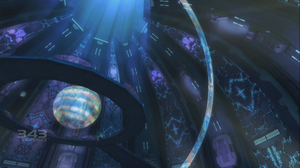
Each Halo has several assets that are uniform to all installations. Each contains a Control Room located somewhere upon its inner surface, from which a Reclaimer must manually insert the installation's Activation Index to activate it. Each also possesses a Library, a large structure protected by an energy shield, where the Index is housed and protected by Sentinels.[7][47] The index itself is a semi-solid holographic representation of the data needed to activate the ring, and can only be directly inserted successfully by a Reclaimer.
Installations also possess Cartographer facilities, which contain the complete, real-time record and schematic of the installation,[48] including its inner passages and networks, to be used as a navigational reference for traversing the installation. Flood containment and research facilities are also standard, used by the installation's monitor to conduct research on and observe the surviving Flood specimens; these are protected by Sentinels to prevent an outbreak.[49]
Installations also contain advanced teleportation grids, allowing instantaneous transportation for a Monitor or Reclaimer to any place on the installation. These grids cannot be controlled by the Flood, though the Gravemind was able to use that of Installation 05 by controlling 2401 Penitent Tangent.[3] For Sentinels, the installation is riddled with tunnel and cave networks for access and transportation.[49] The Sentinel portals are connected to factories via tunnels.
The Halo rings achieve their "gravity" through centripetal force. As the ring spins, centripetal force pushes all spinning bodies away from the center of rotation. The ring is uniform, and because of this, all points are the same distance from the center, therefore centripetal force applies evenly. This force also pushes objects on the surface of the ring away from the center of rotation, or pushes them down on the surface of the ring, translating into gravity. When the UNSC Pillar of Autumn was detonated, it blasted a large mass from Installation 04; no longer a full loop, the centripetal force applied in much greater strength on the newly formed weak point, causing the ring to rip apart.
The Halo installations are also equipped with drive engines spaced along their rim. In the event of an emergency, a Halo can maneuver itself to avoid damage from a collision or weaponry.[50] In addition, they possess hard light reinforcement to stabilize and protect them against tidal and gravitational forces from other objects.[51] One of the most extraordinary systems possessed by the Halos is their ability to lock entire sections of the ring, or, if necessary, the entirety of it, into reflective slipspace stasis. This effectively suspends these sections in time and renders them invulnerable to damage from the outside and allows the occupants of the ring to survive the main weapon's firing. However, it also consumes an enormous amount of energy.[52]
The Halos are capable of repairing themselves to some degree, replacing damaged plates of foundation material and restoring biological sections.[53] Some of the 30,000 km-diameter Halos could also be reduced to a smaller size by shedding large portions of the foundation.[23] In order to prevent the ring from falling apart during this process, it can generate a hard light hub with spokes which hold each of the foundation plates in place.[54] However, the self-reduction process was far from perfect and made the original Halos prone to instability and collapse.[23]
The rings of the second Halo Array are 10,000 km in diameter; this size is roughly similar to that of Earth, which is 12,756 km in diameter. The surface of each ring is 318 kilometers wide.[55] The original twelve Halo rings were 30,000 km in diameter.[56] Each installation in the final array orbits a large, dense planet—most commonly a gas giant—which serves as a gravitational anchor.[8] For example, Installation 04 and Installation 05 orbited Threshold and Substance, respectively, which are both large gas giants, while Installation 03 is anchored to a large rocky planet.[9]
Firing method
When activated, the Halo rings release a burst of cross-phased supermassive neutrinos.[57] This burst of neutrinos is carefully tuned to possess a harmonic frequency, which destroys the nervous system of any macroscopic organism that possesses one, even one as rudimentary as a notochord, as shown in the aftermath of a low-powered test firing of a Halo performed by Mendicant Bias in the system of Charum Hakkor.[58] Like virtually all Forerunner technology, the Halos are powered by vacuum energy; when the main weapon is fired, vacuum energy is siphoned from local space-time to near-depletion.[24]
This pulse is propelled at superluminal speeds and will eventually propagate at a near-infinite velocity; this was known to generate causal paradoxes when the rings first fired, with two of the Halos reporting pre-echoes of the combined activation before the rings had been fired.[27] The energy discharge covers the Array's effective range and cleanses it of all affected life, though simpler life forms that do not possess a neural system, such as microbes, fungi, algae, mosses, and traditional plants are unaffected.[59]
The original twelve Halos were designed to fire laterally, generating a cone-shaped field with a maximum effective range of hundreds of thousands light-years. When fired from the greater Ark to the Large Magellanic Cloud, the blast was wide enough to cover the entire 14,000 light-year-wide satellite galaxy.[26] The rings could also be fired on a lower power setting, cleansing specific planets or systems within a relatively small area of effect.[58]
The six smaller Halos (and the reduced Installation 07) were designed to fire in all directions, withing a spherical radius of 25,000 light-years;[12] together, the rings were capable of killing all sentient life within three radii of the Milky Way's center.[6]
Due to the Forerunners' use of corpse-disintegrating solute, 21st century paleo-archeological studies gave no indication of the mass extinction caused by the Array's firing. However, in 2332 the Ross-Ziegler Blip revealed a tiny aberration in Earth's fossil records.[60]
Function
The Halo Array is complex, but each ring can be activated individually by a Reclaimer, also activating the other installations, or they can all be activated simultaneously from Installation 00. In the event of a major Flood outbreak, an installation's Monitor will seek out a Reclaimer if available, whom they will enlist to aid them. It will teleport them to the installation's Library and will assist the individual in retrieving the Index. The Monitor then stores the Index within its data arrays for safe transportation, lest the Reclaimer fall prey to the Flood before they can activate the installation. Once at the control room, the Reclaimer is given back the Index and must insert it into the control panel in order to begin the activation sequence.
The main weapon is amplified by phase pulse generators, three of which are close to the control room, at least on Installation 04. Each installation has a maximum effective radius of 25,000 light-years[12] and functions via form of lethal radiation.[61] The pulse is designed to kill all sentient life in the installation's three-dimensional radius, with the array covering the entire galaxy. The pulse targets the nervous system of sentient life forms via the issuing of a harmonic frequency.[62] The nervous systems of the targeted beings are destroyed, rendering them useless to the Flood; however, the Halo effect does not disintegrate biomass, leaving the victims' bodies mostly intact.[63] Left untreated, lifeforms killed by the pulse will decay in great masses, which could lead to ecological devastation spread by a miasma of rotten biomatter. Therefore, Lifeworkers sprayed target biospheres with a solute that would cause any animal killed by the Array to instantly decay into its component molecules,[64] resulting in flash-desiccation.[65]
The only known ways to avoid the effects of these pulses are to seek shelter in a shield world or to escape outside the range of the array. Once activated from Installation 00, the other installations will fire simultaneously, eradicating all sentient life in the galaxy, thus starving and killing the Flood.[6]
Trivia
- The Halos are remarkably similar to the eponymous megastructure of Larry Niven's Ringworld series. However, Niven's ringworld encircles a large star, whereas the Halos merely orbit planets, being much smaller than the former. The Halos are also very similar to the Orbitals from Iain M. Banks' Culture series, though considerably smaller.
- The names of the Halo installations are Beta, Epsilon, Kappa, Alpha, Delta, Gamma and Zeta Halo, ordered from 01 to 07 respectively.
- The Halo textures for both Halo: Combat Evolved and Halo 2 are the same, and are both symmetrical.
- In a Halo: Combat Evolved prototype, Installation 04 had a section that was only partially constructed. This feature was dropped from the final game, though it may have inspired the design of the second Installation 04.
- On the screen where Captain Keyes taps his pipe on the opening scene of the Pillar of Autumn, TRAJECTORY FD: HALO is displayed by the hologram of Installation 04, although the UNSC was not aware of the name at the time.
- In 2011, the Halo Array was the number 1 most "Ridiculously Oversized Videogame Weapon" by PasteMagazine.com.[66]
Gallery
- POAEngineRoom.jpg
Sentinels fighting the Flood on Installation 04.
Installation 00 sending the Halo Array through a slipspace portal during the Forerunner-Flood war.
A visual reference to a Halo ring in Halo 4: Forward Unto Dawn.

|
Browse more images in this article's gallery page. |
List of appearances
|
|
Sources
- ^ Halo: Combat Evolved, level The Truth and Reconciliation
- ^ Halo: The Flood, page 38
- ^ a b c Halo 2, level Gravemind
- ^ Halo: The Flood, page 193
- ^ a b c Halo: Cryptum, page 274
- ^ a b c d Halo 2, level The Great Journey, 343 Guilty Spark: "After exhausting every other strategic option, my creators activated the rings. They, and all additional sentient life in three radii of the galactic center, died, as planned."
- ^ a b Halo: Combat Evolved, level The Library
- ^ a b Halo: Silentium, page 237
- ^ a b Halo 4, campaign level Composer
- ^ Halo 2, level The Oracle
- ^ Halo: Combat Evolved Anniversary, Terminal 8 ("25,000 light years. That is the effective range of this installation.")
- ^ a b c Halo: Combat Evolved, level Two Betrayals, 343 Guilty Spark: "Technically, this installation's pulse has a maximum effective radius of twenty-five thousand light years."
- ^ Halo: Combat Evolved, level The Library, 343 Guilty Spark: "Why the Flood is, naturally, simply too dangerous to release, and mass sterilization protocols may again need to be enacted."
- ^ Halo: Cryptum, page 132
- '^ Halo: Rebirth
- ^ a b Halo 3, campaign level Halo
- ^ Halo 3, level The Covenant, 343 Guilty Spark: "The Ark is out of range of all the active installations!"
- ^ Halo: Ghosts of Onyx, page ??
- ^ a b Halo: Silentium, page 44
- ^ Halo: Primordium, page 188-190
- ^ Halo: Cryptum, page 329 ("Slowly it dawned on me that I was looking upon another array of installations: six rings, each rising from one of the petals of an enormous flower.")
- ^ Halo: Silentium, pages 250-251
- ^ a b c Halo: Silentium, page 91
- ^ a b c Halo: Silentium, page 270
- ^ a b c Halo: Silentium, page 314
- ^ a b Halo: Silentium, page 273
- ^ a b Halo: Silentium, pages 326-327
- ^ Halo: Silentium, pages 322-323
- ^ "Conversations from the Universe"
- ^ Halo: Combat Evolved Anniversary, Terminals 5-6
- ^ Halo 2, multiplayer level Burial Mounds
- ^ Eleventh Hour reports - #5
- ^ Halo: The Essential Visual Guide, page 14
- ^ Halo: Glasslands, page 50
- ^ Halo 4
- ^ Halo: Combat Evolved, level 343 Guilty Spark
- ^ Halo: Combat Evolved Anniversary, Terminal 1
- ^ Halo 2, level Sacred Icon
- ^ Halo: Cryptum, pages 313, 334
- ^ Halo 2, level Uprising
- ^ Halo: Combat Evolved, level Assault on the Control Room
- ^ Halo 2, level Quarantine Zone
- ^ a b Halo 3, level The Covenant
- ^ Halo 3, level The Ark
- ^ The Art of Halo 3, page 30
- ^ The Art of Halo 3, page 116
- ^ Halo 2, level Sacred Icon
- ^ Halo: Primordium, page 295
- ^ a b Halo: The Flood, pages 240-242
- ^ Halo: Cryptum,, page 314
- ^ Halo: Cryptum, page 311
- ^ Halo: Primordium, page 331-332
- ^ Halo: Primordium, page 77-78
- ^ Halo: Primordium, pages 345-346
- ^ Halo: The Essential Visual Guide, page 6
- ^ Halo: Cryptum, page 310
- ^ Halo: Cryptum, page 274
- ^ a b Halo: Cryptum, pages 131-133
- ^ Halo: Cryptum, page 131
- ^ Halo: Evolutions - Essential Tales of the Halo Universe, From the Office of Dr. William Arthur Iqbal, page 519
- ^ Halo: Ghosts of Onyx, page 183
- ^ Halo Encyclopedia, pages 170-174
- ^ Halo 3, Terminal 6 ("I toss around [37,654 tonne] dreadnoughts like they were fighters; dimly aware of the former crews being crushed to liquescence.")
- ^ Halo: Silentium, String Two
- ^ Halo: Combat Evolved Anniversary, Terminal Eight
- ^ 9 Ridiculously Oversized Videogame Weapons
